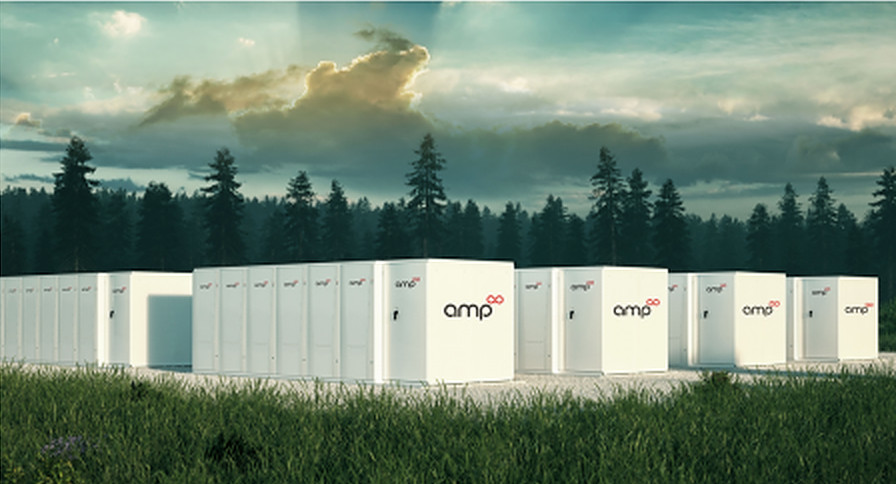Toronto-based renewables owner and developer Amp Energy has secured approval for the Scottish Green Battery Complex, comprising 800MW/1.6GWh of battery storage capacity in central Scotland.
Amp will develop two 400MW batteries, each offering 800MWh of storage capacity and described the systems as the two biggest grid-connected battery storage facilities in Europe.
The developer received planning consent for the projects from the Scottish Government Energy Consents Unit this month.
The batteries will store and manage the dispatch of renewable energy generated at Scottish windfarms, future-proofing the U.K.'s electricity infrastructure at a fraction of the cost of transmission system upgrades, according to Amp Energy.
Decarbonized grid
“With these ground-breaking projects, Amp is making a significant investment in vitally needed green infrastructure as the U.K. transitions to a fully decarbonized grid,” said Ben Skinner, Amp's VP for global markets. “Our projects not only support the growth of renewable generation in Scotland but also provide an alternative to costly transmission upgrades for consumers.”
Amp's facilities will deploy grid-forming inverter technology alongside two new synchronous condensers, which will also help grid stabilization.
Unlike traditional, grid-following inverters, which sync their output to grid voltage waveforms, advanced, or “grid-forming” inverters can set their own frequencies without the inertia required from large spinning hardware. That makes them capable of providing the grid with virtual inertia, instead of the mechanical inertia provided by synchronous generators, reducing curtailment of intermittent renewable energy generation along the way.
A relatively old technology, costly synchronous condensers are bulky spinning machines usually deployed in parts of the grid that host a high share of solar and wind electricity and suffer from system strength issues. In addition to providing short-circuit power and reactive power compensation, “syncons” can also be used to resolve problems related to inertia – imbalances between supply and demand on the grid.
Today, many system engineers believe syncons will gradually be retired and replaced by batteries operating in “virtual synchronous” mode. Such capabilities make batteries function a lot more like traditional fossil fuel plants on the grid and make them capable of delivering almost the same grid services as syncons, such as extremely fast response to network disturbances – usually in less than 100 milliseconds. Some batteries are already trialing such services, including the 30MW/8MWh Dalrymple ESCRI battery on South Australia’s Yorke Peninsula.
Locations
The Scottish Green Battery Complex will be optimized and dispatched by Amp X, the developer's proprietary, AI-powered digital energy platform, which is said to provide solutions to grid constraints. The projects, at Hunterston and Kincardine, will participate in power company National Grid's Scottish Stability Pathfinder 2 tender, which seeks to address voltage and stability issues faced by the U.K. electricity grid, and to provide grid stability services and power management across the central belt of Scotland, including for Glasgow and Edinburgh.
Amp said the Scottish batteries will enable up to 1.75TWh per year of additional renewable energy to be generated in Scotland and transported to other U.K. locations, the equivalent of enabling around 500MW of new offshore wind projects in the coming years.
Solar sidelined
Scotland is keen on expanding its wind power fleet whereas solar has been largely sidelined in the nation's transition to net zero. In its new energy strategy, released last year, the Scottish government outlined an ambition for 8-10GW of onshore wind farms this decade on top of an existing goal of 11GW of offshore facilities. Of solar, the government said only that the technology could play “an important role in continuing to decarbonize our heat and electricity supply.” While national PV trade body Solar Energy Scotland welcomed the mention of photovoltaics in the document, the policy paper fell short of the group's call for 4-6GW of solar generation capacity to be installed by 2030.
In an historic windfarm auction held this month, the Scottish Crown Estate – comprising land and holdings which belong to Queen Elizabeth II but whose revenues finance the Scottish Parliament – awarded seabed permits to 17 companies to build nearly 25GW of offshore wind project capacity under the ScotWind leasing program. Those projects, to be developed over the next 10 years, will more than double the extent of the U.K.’s current 10GW of offshore wind facilities, and be equal to Europe’s current combined capacity.
This content is protected by copyright and may not be reused. If you want to cooperate with us and would like to reuse some of our content, please contact: editors@pv-magazine.com.




Funny, they can do this in Scotland but not in Canada nor the home province of Ontario. We (Ontario Residents) have a lot of Wind and ZERO Storage and the current Ford Administration even tore down Wind Farms and chased away EV Makers and pays Lip Service to the Big 3 and other issues. It’s OKAY though, they are dumping 35 Billion to refurb Nuke Generators instead.